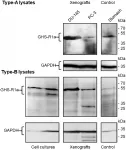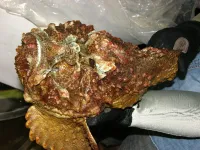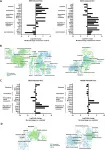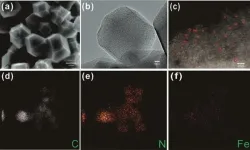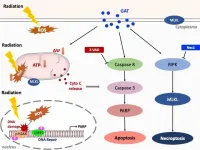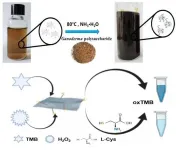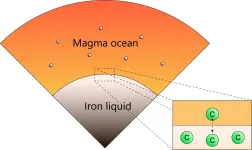(Press-News.org) Oncotarget published "Development of a ghrelin receptor inverse agonist for positron emission tomograph" which reported that imaging of Ghrelin receptors in vivo provides unique potential to gain deeper understanding on Ghrelin and its receptors in health and disease, in particular, in cancer.
Ghrelin, an octanoylated 28-mer peptide hormone, activates the constitutively active growth hormone secretagogue receptor type 1a with nanomolar activity.
The authors developed novel compounds, derived from the potent inverse agonist K- -FwLL-NH2 but structurally varied by lysine conjugation with 1,4,7-triazacyclononane,1-glutaric acid-4,7-acetic acid, palmitic acid and/or diethylene glycol to allow radiolabeling and improve pharmacokinetics, respectively.
All compounds were tested for receptor binding, potency and efficacy in vitro, for biodistribution and -kinetics in rats and in preclinical prostate cancer models on mice.
Due to their easy synthesis, high affinity, medium potency, metabolic stability, and the suitable pharmacokinetic profiles, they are excellent tools for imaging and quantitation of GHS-R1a expression in normal and cancer tissues by PET. These compounds can be used as novel biomarkers of the Ghrelin system in precision medicine.
Dr. Ralf Bergmann from The Institute of Radiopharmaceutical Cancer Research as well as The Semmelweis University said, "The growth hormone secretagogue receptor type 1a (GHS-R1a) is the known biological relevant receptor of the endogenous ligand and pleiotropic hormone Ghrelin (acronym growth hormone release inducing), which mediates a broad range of complex biological functions [1], such as regulation of the body weight, body composition and energy expenditure."
"The growth hormone secretagogue receptor type 1a (GHS-R1a) is the known biological relevant receptor of the endogenous ligand and pleiotropic hormone Ghrelin (acronym growth hormone release inducing), which mediates a broad range of complex biological functions [1], such as regulation of the body weight, body composition and energy expenditure."
The occurrence of Ghrelin and GOAT in stomach and pancreas tissues demonstrates the relevance of GOAT in the acylation of Ghrelin and further implicates acylated Ghrelin in pancreatic function.
Although widely studied as a promising drug target, the knowledge about Ghrelin signaling, behavior, dynamic interactions with its receptor and functional receptor expression in vivo is still limited and basic bioscientific research is warranted to further evaluate the safety and benefits of Ghrelin drug treatment in patients with cancer.
In order to develop imaging probes targeting the Ghrelin receptor, the inverse agonist radiotracer 68Ga-NODAGA-KwFwLL-NH2 1 was previously designed for PET imaging.
The focus of the present study was to develop potent inverse agonist radiotracers targeting the Ghrelin receptor as potential imaging and therapeutic agent.
Furthermore, they demonstrated specific binding to GHS-R1a and imaging of tumors and normal tissues expressing the Ghrelin receptor with 64Cu2 - and 68Ga3 -radiolabeled inverse agonist NODAGA-KK- -FwLL-NH2 in xenografted prostate tumor models in mice.
The Bergmann Research Team concluded in their Oncotarget Research Output that the data support that the studied radiometal Ghrelin inverse agonists could be used for the imaging of functional expression of Ghrelin receptors in vivo that these radiotracers have the potential to gain a deeper understanding on Ghrelin and its receptors in vivo in health and disease, in particular, in cancer.
The Ghrelin binding, constitutively active growth hormone secretagogue receptor type 1a has been imaged and quantified by the developed novel compounds, structurally based on the potent inverse agonist KK- -FwLL-NH2 that were evaluated for receptor binding and efficacy in vitro.
In the biodistribution experiments the 10c reached at two hours a 2.68 ± 1.11 SUV in the tumor and could be blocked by Ghrelin and KKD to 1.28 ± 0.22 SUV and 1.26 ± 0.34 SUV, respectively.
In addition, the biodistribution 10c in rats and mice showed specific accumulation of the radiotracers in GHS-R1a expressing tissues, like stomach and thyroid in which the radiotracer uptake has been partially blocked by KKD.
The Cu- or Ga-NODAGA-NH-K-K- -F-w-L-L-NH2 radiolabeled inverse agonists with respect to its relative simple synthesis, high affinity and medium efficacy, high metabolic stability, and the suitable pharmacokinetic profiles, seem to be potent, and safe leads of future imaging agents for visualization and quantitation of GHS-R1a expression in normal and cancer tissues by PET. The GHS-R1a in vivo imaging and quantitation has the potential to serve as biomarkers of the Ghrelin system in precision medicine.
INFORMATION:
DOI - https://doi.org/10.18632/oncotarget.27895
Full text - https://www.oncotarget.com/article/27895/text/
Correspondence to - Ralf Bergmann - r.bergmann@hzdr.de
Keywords - cancer, prostate cancer, growth hormone secretagogue receptor (GHS-R), small animal imaging, copper-64
About Oncotarget
Oncotarget is a bi-weekly, peer-reviewed, open access biomedical journal covering research on all aspects of oncology.
To learn more about Oncotarget, please visit https://www.oncotarget.com or connect with:
SoundCloud - https://soundcloud.com/oncotarget
Facebook - https://www.facebook.com/Oncotarget/
Twitter - https://twitter.com/oncotarget
LinkedIn - https://www.linkedin.com/company/oncotarget
Pinterest - https://www.pinterest.com/oncotarget/
Reddit - https://www.reddit.com/user/Oncotarget/
Oncotarget is published by Impact Journals, LLC please visit https://www.ImpactJournals.com or connect with @ImpactJrnls
Media Contact
MEDIA@IMPACTJOURNALS.COM
18009220957x105
Copyright © 2021 Impact Journals, LLC
Impact Journals is a registered trademark of Impact Journals, LLC
Oncotarget published "Global DNA hypermethylation pattern and unique gene expression signature in liver cancer from patients with Indigenous American ancestry" which reported that contrasting with this pattern, the age structure of HCC in Andean people displays a bimodal distribution with half of the patients developing HCC in adolescence and early adulthood.
To deepen the understanding of the molecular determinants of the disease in this population, the authors conducted an integrative analysis of gene expression and DNA methylation in HCC developed by 74 Peruvian patients, including 39 adolescents and young adults.
While genome-wide hypomethylation ...
New research from the Prevention Research Center of the Pacific Institute for Research and Evaluation, The Ohio State University, and San Jose State University finds that during COVID-19 stay-at-home orders, parental stress was higher during the workday compared to after the workday and lower during weekends than during weekdays.
Previous research compares parental stress before and during the pandemic, but none has measured it during stay-at-home orders. In this study, scientists assessed how time-varying and day-varying factors are related to parents' level of stress. In specific, stress was examined 3 times a day for 14 days for survey participants in Ohio from April to May 2020.
Specific findings include:
Parents ...
University of Queensland scientists working to unlock the mysteries Australia's deadly stonefish have made a discovery which could change how sting victims are treated in the future.
Stonefish are the most venomous fish in world and are found throughout shallow coastal waters of the northern half of Australia.
Study co-author Associate Professor Bryan Fry said previous studies have not been able to uncover all of the mechanisms at play in stonefish venom because of the way the venom was tested.
"There's a couple of reasons previous studies haven't been able to thoroughly decipher the toxicological mysteries of stonefish venom," Dr Fry said.
"But ...
Oncotarget published "Multi-modal effects of 1B3, a novel synthetic miR-193a-3p mimic, support strong potential for therapeutic intervention in oncology" which reported that the authors comprehensively investigated miRNA-193a-3p's mode of action in a panel of human cancer cell lines, with a variety of genetic backgrounds, using 1B3, a synthetic microRNA mimic.
Interestingly, the exact mechanism through which 1B3 reduced cell proliferation varied between cell lines.
1B3 efficiently reduced target gene expression, leading to reduced cell proliferation/survival, cell cycle arrest, induction of apoptosis, increased cell senescence, DNA damage, and inhibition of migration.
SiRNA ...
A local research team, comprised of members of the Korea Institute of Machinery and Materials(KIMM) under the Ministry of Science and ICT and UNIST, developed a metamaterial absorber that significantly enhances the detection of harmful substances or biomolecules, and published their results in Small Methods.
The joint research team led by Principal Researcher Dr. Joo-Yun Jung of the Nano-Convergence Mechanical Systems Research Division at KIMM and Professor Jongwon Lee of UNIST developed a metamaterial that enhances infrared absorption spectroscopy through 100-fold amplification of detection signals. The proposed metamaterial is a special functional material with vertical nanogaps of a smaller size than infrared wavelength.
Infrared spectroscopy is a technique that identifies ...
Recently, the research team led by Prof. KONG Lingtao from Institute of Solid State Physics, Hefei Institutes of Physical Science (HFIPS) prepared a highly active single iron atom catalyst (Fe-ISAs@CN) which can activate H2O2 to generate free radicals, achieving rapid removal of sulfadiazine pollutants in aqueous. The relevant results were published in Journal of Colloid and Interface Science.
Sulfadiazine (SDZ), a kind of synthetic sulfadiazine antibiotic, is widely used in clinical and animal husbandry industries. However, due to its large-scale use and unqualified discharge of wastewater, more and more antibiotic residues ...
Recently, the research team led by Prof. KONG Lingtao from Institute of Solid State Physics, Hefei Institutes of Physical Science (HFIPS) prepared a highly active single iron atom catalyst (Fe-ISAs@CN) which can activate H2O2 to generate free radicals, achieving rapid removal of sulfadiazine pollutants in aqueous. The relevant results were published in Journal of Colloid and Interface Science.
Sulfadiazine (SDZ), a kind of synthetic sulfadiazine antibiotic, is widely used in clinical and animal husbandry industries. However, due to its large-scale use and unqualified discharge of wastewater, more and more antibiotic residues are detected in the ...
Graphene-based materials can be obtained using various reducing agents, many of which are dangerous and toxic chemicals, and the obtained graphene-based materials are prone to aggregation, limiting their practical applications.
Recently, a research group of Prof. HUANG Qing from the Institute of Intelligent Machines, Hefei Institutes of Physical Science (HFIPS), prepared graphene-based nanozymes through a simple and green preparation method, and verified that it can be used to detect L-cysteine in serum.
The study, published in Analytical and Bioanalytical Chemistry, was supported by the National Natural Science Foundation ...
According to the theory of planet formation, rocky bodies such as the Earth were formed by repeating collisions from dusty materials. In this process, a number of Mercury- or Mars-sized planetary embryos, were formed, and eventually these bodies merged together and formed terrestrial planets in our solar system. During the formation of the planetary embryos, the interior of these bodies was likely to be molten due to the heat by radiative-decay elements and a collisional energy of the planetary embryos. At this stage, iron and silicate separate, and form the metallic core and ...
It might seem like a given that mothers take extra risks to protect their children, but have you ever wondered why? A new study led by Kumi Kuroda at the RIKEN Center for Brain Science (CBS) in Japan shows that in mice, this and other nurturing behaviors are driven in part by neurons in a small part of the forebrain that contain a protein called the calcitonin receptor. The study was published in Cell Reports.
Many simple behaviors, such as eating and drinking, are driven by different parts of the brain's hypothalamus. The new study focused on identifying the part that drives a much more complicated behavior: caring for infants. As Kuroda explains, "we were able to narrow down the brain cells necessary ...
